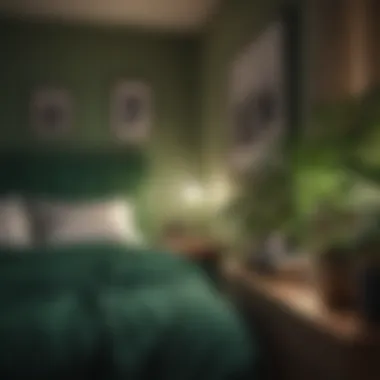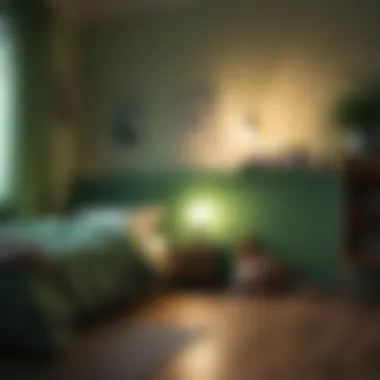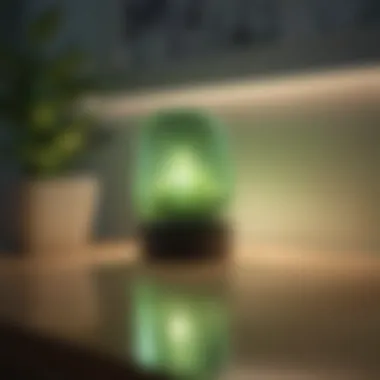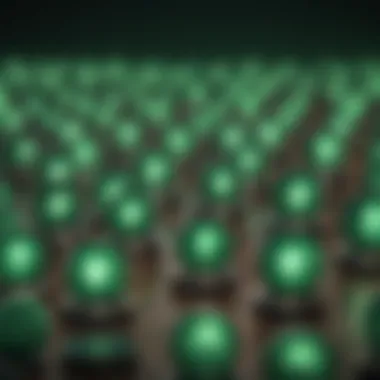The Role of Green Night Lights in Modern Spaces


Intro
As urban life becomes increasingly fast-paced, the quest for restful environments is paramount. Among the variety of home decor elements, green night lights have emerged as intriguing fixtures, offering more than mere illumination. They play a significant role in promoting comfort and enhancing the aesthetic appeal of living spaces. Beyond their visual charm, these lights have an impact on psychological well-being, especially when it comes to sleep quality and childhood development.
As we journey through this exploration, we will unveil the layers of significance that these green night lights bring into our homes. You’ll uncover the ways they can serve as design statements while also diving into the science behind their calming hue. Are they merely decorative items or is there a deeper connection to our relaxation and sleep patterns? Let’s dig deeper into the intricacies of these lights and how you can use them effectively in your own spaces.
Design Inspiration
The realm of design is constantly evolving, driven by trends that reflect our lifestyles and preferences. When it comes to integrating green night lights into your home decor, understanding the latest styles and color themes can guide your choices and enhance your environment.
Trending Design Styles
In recent years, minimalistic approaches have taken center stage. This design style emphasizes simplicity and functionality, aligning beautifully with green night lights. Incorporating these lights into a Scandinavian or contemporary design can add a touch of warmth and relaxation to otherwise stark spaces. Imagine a sleek nightstand topped with a subtle green glow, providing a serene feel without overwhelming the senses.
However, don’t overlook the charm of bohemian decor. This style often embraces vibrant colors and eclectic elements. A green night light can tie together the various layers of color present, acting as a gentle anchor amid a collage of patterns. Using textured lampshades with a hint of green can create depth and character, offering both utility and beauty.
Color Palettes and Themes
The psychology of color plays a critical role in our emotional responses and interactions with our environment. Green, often associated with nature, tranquility, and growth, can evoke a sense of balance and calm. When selecting color palettes, consider pairing green night lights with softer hues like cream, pale blue, or even muted earth tones.
An interesting approach can be found in accentuating greens with contrasting deep colors like navy or charcoal. This creates a striking visual, turning a simple night light into a focal point in the room.
"Color is the keyboard, the eyes are the harmonies, the soul is the piano with many strings." – Wassily Kandinsky
Practical Tips
Integrating green night lights into your home involves not just aesthetics but functionality as well. Here are some practical tips to maximize their potential 효과.
Space Optimization Techniques
Strategically position your green night lights in areas where they can enhance both ambiance and functionality. For example, placing them on nightstands or shelves can serve multiple purposes: they illuminate dark corners while adding visual interest. Spaces like hallways or entryways can also benefit from these lights, offering a welcoming glow without being harsh on the eyes.
When arranging your space, consider the distances and angles to create a cohesive flow. Lights that cast gentle shadows can contribute to the overall atmosphere, avoiding overpowering bright light that might disrupt relaxation.
DIY Furniture Projects
For the adventurous spirits out there, harnessing DIY projects can personalize your night light experience. Creating a custom shelving unit with integrated LED green lights can add functionality while showcasing your style. For those who enjoy crafts, designing lampshades with translucent fabrics in shades of green can alter the light's ambience beautifully.
Consider finding unused vessels or jars, combining them with string lights for a quirky twist. This can elevate the green lighting experience to an art form in itself, blending creativity with practical application.
Understanding Night Lights
Exploring green night lights provides an interesting look into a seemingly simple item that plays a significant role in our daily lives. Night lights, often seen as mere fixtures for illumination, actually hold deeper meanings and usages that can enhance comfort and functionality in various settings. Understanding their place in both practical use and aesthetic value helps illuminate their importance in contemporary living spaces.
Defining Night Lights
Night lights can be broadly defined as low-level illumination devices designed to provide just enough light to navigate spaces during the dark hours. These fixtures serve multiple purposes: they enhance safety, foster comfort, and add to the overall ambiance of a room. The term can refer to traditional plug-in models, LED strips, or even decorative lights that provide a soft glow.
Aside from their obvious use—helping us avoid stubbed toes in the dead of night—night lights can evoke feelings of relaxation and security. Consider, for instance, how many parents rely on these gentle rays to reassure their children during the wee hours. Indeed, these little lights do much more than just fill a room with illumination; they create a sense of warmth and refuge, especially in unfamiliar spaces.
Historical Perspectives on Lighting
Lighting has come a long way from its humble beginnings. Historically, night lighting has evolved significantly, reflecting changes in technology, culture, and household needs. In the past, people relied on candles, oil lamps, and gas lights to manage darkness. These sources, while functional, also came with inherent dangers—think about the fire hazards or the unpleasant odor of burning oil.
When electric lights became commonplace in the late 19th century, they introduced a whole new world of possibilities. Suddenly, the dim glow that once beckoned through cracks in doors transformed into bright and adjustable light sources, opening opportunities for innovation in design and function. The focus shifted from simply illuminating spaces to intentional lighting that complements life.
Green night lights have carved out a niche within this history, representing a blend of functionality and aesthetics. The color green itself has roots in symbolism and psychology, often associated with peace and tranquility. As homeowners began looking for ways to incorporate more calming hues into their spaces, green night lights emerged as a favorite—offering both utility and a soothing atmosphere.
Ultimately, the evolution of night lights—from flickering flames to sleek, modern designs—reflects wider societal shifts. Today, understanding these changes is key for homeowners, designers, and enthusiasts aiming to tap into not just light, but feeling and experience within a given environment.
The Color Green in Interior Design
The role of color in interior design extends far beyond mere aesthetics. The color green is particularly noteworthy, often associated with nature, tranquility, and rejuvenation. Infusing green into interior spaces can lead to lush and vibrant atmospheres, promoting a sense of well-being that aligns perfectly with the calming qualities green night lights offer.
Symbolism of Green
Green, often seen as the color of life, symbolizes growth and renewal. In various cultures, it carries different connotations; for example, in Western societies, green is frequently linked to freshness and fertility, while in some Eastern cultures, it can represent harmony and balance.


When incorporating green in design, whether through paint, furnishings, or lighting, one evokes a certain vitality in the home. Green can reflect the lushness of nature, making spaces feel more open and connected to the outside world. It’s not just about the physical color but the emotions it can stir. As a result, many homeowners intentionally include green elements to induce feelings of peace and calm in their living environments.
"Colors, like features, follow the changes of the emotions." – Pablo Picasso
Psychological Impacts of Green Lighting
The psychological effects of lighting color, specifically green, are profound and multifaceted. Studies have shown that exposure to green light can lead to reduced anxiety and increased relaxation. This is particularly beneficial in spaces designed for rest and rejuvenation, such as bedrooms and relaxation areas.
Key Benefits of Green Lighting Include:
- Promoting Restfulness: Green light is not overly stimulating, which can help prepare the mind and body for sleep.
- Enhancing Focus: Some studies suggest that green hues can enhance concentration and mental clarity, making them ideal for home offices or study areas.
- Boosting Creativity: The association of green with nature and renewal can foster creativity, encouraging new ideas and innovation in design.
Benefits of Green Night Lights
Green night lights bring a lot to the table, especially when it comes to integrating them into modern living spaces. The subtleties of light can profoundly influence our daily lives, and green is particularly special. Not only does it lend an aesthetically pleasing ambiance, but it also carries a range of benefits worth delving into. From enhancing our ability to relax to playing a pivotal role in energy savings, the advantages of employing green night lights cannot be overlooked.
Influence on Sleep Quality
Let's start with sleep. The age-old struggle for a good night's rest is something many are familiar with. Green night lights present a gentler option for nighttime illumination. Unlike harsher hues such as blue or white, which can interfere with our melatonin production, green light tends to have a calming effect. This kind of lighting allows the body to ease into sleep rather than battling against bright, disruptive lights.
Research has shown that green wavelengths can promote a sense of tranquility, making it easier to wind down after a long day. Placing these lights in strategic spots, like beside the bed or in the hallway, provides enough illumination for late-night trips without jolting the brain awake. Many night owls have attested to a noticeable improvement in sleep quality after switching out their bright night lights for softer, green options.
"Creating a comforting atmosphere at night helps the mind relax, making it easier to drift into sleep."
Impact on Children's Development
Now, turning our attention to children, the impact of light on their development is remarkable. Kids are especially sensitive to their environments, and the right kind of lighting can play a key role in their emotional well-being. Introducing green night lights in children’s rooms serves multiple purposes. They not only alleviate fears of darkness but also help in establishing a soothing routine.
Research indicates that calm lighting, like green, can enhance cognitive development and emotional stability in children. It supports a serene environment conducive to reading or play, without overwhelming their senses. Parents have noted that green night lights are less likely to cause anxiety compared to brighter lights, allowing kids to settle down more easily at bedtime.
Energy Efficiency Considerations
When it comes to practicality, energy efficiency is an ever-relevant topic in modern homes. Green night lights typically come with LED technology, known for consuming less power than traditional bulbs. This makes them not only environmentally friendly but also kind to your wallet. Families looking for sustainable solutions often consider green night lights as a viable option.
Weighing the pros and cons:
- Energy Savings: LED green night lights reduce electricity bills.
- Longevity: They can last significantly longer than conventional bulbs.
- Eco-Friendly: Utilizing less energy aligns with sustainable living goals.
In summary, the benefits of green night lights extend beyond mere illumination. They offer a holistic approach to sleep, child development, and energy savings, making them essential for thoughtfully designed living spaces.
Types of Green Night Lights
In the realm of night lighting, the choice of type can radically shape the atmosphere and functionality of our spaces. Examining the various types of green night lights reveals their unique characteristics, pros, and cons that cater to different needs and preferences. This discussion helps homeowners, designers, and enthusiasts make informed decisions, ensuring that the lighting they select not only serves a purpose but also enhances the overall aesthetic and emotional tone of their environments.
LED Versus Traditional Bulbs
When we dive into the comparison between LED and traditional bulbs, it’s obvious that LED lights have taken the front seat in many households. These modern marvels are not just energy-efficient; they also save a ton of money in the long run. For instance, an LED green night light typically consumes about 80% less power than its incandescent counterpart. Furthermore, LEDs boast a lifespan that can extend up to 25,000 hours, significantly overshadowing traditional bulbs that generally last for merely 1,000 hours.
One of the key considerations here is the heat generated. Traditional bulbs emit substantial heat, which could be a concern if left on overnight, especially in children’s rooms. LED lights stay cooler, making them safer for prolonged use. However, some folks miss the warm glow of traditional bulbs, especially the nostalgic aura they exude. Therefore, it’s worthwhile to consider both their functional and emotional impact on the living space.
Smart Night Lights
In recent years, smart technology has been permeating every facet of our lives, and night lights are no exception to this trend. Smart green night lights not only emit a soothing glow but also invite a range of functionalities. For example, many of them come equipped with features like motion sensors, timers, and even integration with home automation systems.
The appeal of smart night lights is multifaceted. Homeowners can set them to adjust according to their daily rhythms or even when they’re away, ensuring that energy is conserved without sacrificing comfort. Imagine a night light that gradually dims when you’re settling in for sleep or brightens subtly when it senses movement to guide you safely to the restroom without jarring you awake. Practical, right?
Moreover, several models allow users to customize their color settings through a smartphone app, creating a personalized lighting environment which can be quite refreshing. Yet, it’s prudent to keep in mind that smart devices require a stable Wi-Fi connection, and depending on setup, there might be an initial learning curve involved in operating them effectively.
Decorative Options
For those looking to infuse some flair into function, decorative green night lights serve as both utility and art. These lights come in creative designs, from whimsical shapes like stars or animals to elegant fixtures that complement sophisticated decor. They can be conversation starters, flaunting both function and style.
Selecting a decorative night light allows homeowners to express personal style while also considering practical use. For instance, some night lights incorporate intricate lampshades that diffuse the light beautifully, creating a soft ambiance conducive to relaxation. Others may feature vintage designs that harken back to historical lighting styles, blending modern technology with classic aesthetics.
However, while aesthetics may be dominant, it’s essential to ensure that the selected options also meet the intended purpose. A hall light, for example, should ideally emit a broader glow compared to a bedside lamp meant for reading.


"Choosing the right type of night light is like finding the perfect pair of shoes; it should suit your needs but also reflect your personality."
In summary, understanding the distinctions between different types of night lights allows for a more tailored approach to enhancing living spaces. Whether one leans towards LED efficiency, the multifunctionality of smart lights, or the aesthetic charm of decorative choices, there’s a green night light out there to illuminate every nook and cranny of your home.
Placement Strategies for Effective Use
Understanding where to place green night lights can greatly enhance their efficacy and overall impact in a living space. The strategic positioning of these lights can not only influence the atmosphere of a room but also contribute to wellness and functionality. This section outlines several effective placement strategies, shedding light on their importance in achieving desired effects.
Optimal Locations in the Home
Selecting the right spots for green night lights is crucial. Each room in a home serves different purposes, and what works well in one area may not be ideal in another. Here are some optimal locations to consider:
- Bedrooms: Place green night lights near the bed for easy access during the night. This way, they help maintain visibility without causing abrupt wakefulness. At a low level, the soft glow can act as a comfort, especially for kids.
- Hallways: Installing green night lights in hallways can significantly assist with navigation without overwhelming brightness. This can be particularly important during late-night trips to the bathroom.
- Stairs: Positioning lights at the base and mid-point of stairs can provide safety. A well-placed green light will guide users effectively without blinding them in the dark.
- Children’s Rooms: Incorporating night lights in children’s spaces can ease fears of the dark. It creates a calming ambiance conducive for sleep.
- Living Areas: Dim lights in corners can give a cozy feel to the room without overshadowing main lighting sources.
Height and Orientation Considerations
The height and orientation of green night lights are essential elements that can impact both aesthetic appeal and functionality. It’s not just about where you set them, but how they fit into the overall design of your space:
- Height Matters: Installing lights at eye level is often effective for areas where you're seated, such as living rooms or reading nooks. However, lower placements are typically better for children's rooms, as they provide a grounded light source without distortion.
- Orientation: The direction in which the light faces can greatly alter the ambiance it produces. A direct light up against the wall tends to create a pleasant glow while minimizing glare.
Incorporating these strategies enhances not just the functionality of green night lights but also their aesthetic contribution to a space. Careful consideration of placement can yield a more serene environment, conducive to relaxation and rest.
"The placement of a night light is just as important as the light itself. It transforms the way a space feels and operates at night." - Interior Design Expert
By evaluating these elements, homeowners and designers can maximize the impact of green night lights, creating atmospheres that foster comfort and safety.
Comparative Analysis of Color Temperatures
In examining the nuances of green night lights, understanding the comparative analysis of color temperatures stands as a foundational aspect. The subtleties in various shades can greatly affect not only the aesthetic appeal but also the mood and functionality of a space. This section delves into the benefits and considerations tied to different color temperatures of green light, allowing homeowners and designers to make informed decisions based on ambiance, psychological effects, and practical applications.
Warm, Neutral, and Cool Greens
When discussing color temperatures, it's essential to characterize green light in terms of "warm," "neutral," and "cool" shades. Each category possesses unique qualities that can cater to diverse preferences and situations.
- Warm Greens: These shades tend to have a slight yellow hue mixed with green. Warm greens can elicit feelings of comfort and coziness, making them ideal for spaces where relaxation is a priority, like bedrooms or reading nooks. Think of a gentle fern green or soft mint with a warm undertone.
- Neutral Greens: These are balanced tones that don't lean toward either warm or cool spectrums. They're versatile and suitable for various settings, often used in modern interior designs. Olive and sage green commonly fall into this category, offering a grounded feel without dictating the atmosphere too strongly.
- Cool Greens: These shades carry more blue undertones, creating a refreshing and vibrant ambiance. Cool greens can invigorate a space and are often chosen for home offices or creative areas where energy and focus are paramount. Colors like teal or aqua are great examples of this type.
It’s worth noting that the proper use of these shades can enhance not just the aesthetics but also encourage certain behaviors and emotions.
Effects on Atmosphere
The effects of different green shades on a room's atmosphere cannot be overstated. Each color temperature contributes distinctly to the feelings and perceptions of those who inhabit the space. For instance:
- Warm green lighting can soften the harshness of nighttime illumination, encouraging a sanctuary-like feel. Perfect for winding down after a long day, these hues wrap spaces in comfort.
- Neutral greens can provide a calm backdrop for interaction, whether it’s family gatherings or quiet evenings. They create an inviting environment that is placid yet engaging.
- Cool green tones are sharper and elevate the energy levels in a space. They invigorate and are often associated with creativity, making them suitable for areas involving mental workout.
"Color is the keyboard, the eyes are the harmonies, the soul is the piano with many strings." - Wassily Kandinsky, emphasizing how color profoundly connects with emotional and mental responses.
In summation, the analysis of warm, neutral, and cool greens sheds light on how color temperature shapes environments. Homeowners can tailor their lighting choices to foster desired atmospheres, leveraging the psychological potency of color to create spaces that resonate with their personal needs and lifestyle. Understanding these dynamics allows for a thoughtful approach in both design and function, leading to a more harmonious living experience.
Cultural Perspectives on Night Lighting
When discussing the intricate roles that various types of lighting play in our lives, the focus sometimes tends to shift away from culture. Yet, this aspect is profoundly important. Cultural perspectives on night lighting can provide us with a deeper understanding of how green night lights fit into the broader tapestry of human experience. Different societies have unique approaches to how light is used at night, often reflecting historical, environmental, and social factors. Green lighting, in particular, holds specific significance.
In many cultures, colors carry meanings that affect not only mood but also beliefs and practices. Green, often associated with nature, prosperity, and tranquility, stands out in these discussions. In terms of night lighting, this can translate to perceptions of safety, comfort, and even spirituality. For instance, in some parts of East Asia, green shades are thought to ward off evil spirits while promoting peaceful sleep. This view may lead to a preference for green night lights in bedrooms and living areas.
Regional Preferences
The choices we make about night lighting can heavily rely on regional influences.
- Influences from Nature: Northern tribes may favor warmer tones due to harsher winters, dimming the coldness during sleepless nights, whereas tropical areas might lean towards vibrant colors like green, reflecting their lush surroundings.
- Cultural Traditions: In cultures where night markets are common, lights are vibrant and lively, enticing visitors to stay longer. Here, a green night light could represent relaxation amidst the hustle and bustle, perhaps being less common but increasingly sought after for home use.
- Functional and Aesthetic Needs: In urban settings, neon colors reign supreme while rural environments may seek softer, less aggressive hues. Therefore, regional preferences play a significant role in the adoption of green night lights as they often leave a mark on personal tastes and general atmosphere.
Night Lights in Folklore
The stories we tell often illuminate our beliefs and cultural practices surrounding objects in our environment. Night lights find their place in folklore as well. Many cultures have legends and fables that involve light, and specifically green light. These narratives can carry various lessons, fears, or idle beliefs.
- Myths and Beliefs: In some Native American cultures, it is said that a green light in the wilderness signals guidance from spirits, suggesting safety and positivity. This can translate into the home, where people may use green lights in their living spaces as a way to attract positive energies.
- Cautionary Tales: On the flip side, certain tales might warn against reliance on artificial lights, cautioning that those who look towards them too heavily may miss the beauty of natural illumination, the stars included. Hence, modern usage of night lights could reflect a balance between accessibility and reverence for the natural world.
- Cultural Symbolism: For many, folklore attaches a nostalgic value to light; it represents warmth, safety, and togetherness. Access to soft, communal green light can foster connections among families, making night lights an essential part of communal life, particularly in areas rich in storytelling traditions.


Overarching all of these points is a central motif: green night lights are more than just a functional accessory. They bridge personal preferences with cultural meanings, ultimately enriching living spaces in ways deeply rooted in diverse traditions. Understanding these nuances can enhance how homeowners, designers, and enthusiasts approach the atmospheric benefits of green night lights.
User Experiences and Testimonials
Gaining insight into user experiences and testimonials concerning green night lights can be incredibly enlightening, especially for homeowners, designers, and retail agents. These views not only highlight how green night lights are reshaping living spaces but also provide a real-world perspective on the benefits and challenges associated with their use. Understanding these elements can empower consumers and professionals alike to make informed decisions about their lighting choices.
Positive Impacts on Household Dynamics
It's fascinating how something as simple as lighting can have a profound impact on household dynamics. Many families have found that green night lights create a calming atmosphere, promoting relaxation and reducing stress levels. The subtle glow of soft green light can work wonders, especially during nighttime routines for children. For instance, parents often share how their children feel more at ease when they have a gentle light in their rooms. It seems to offer a sense of security, transforming their perception of the dark.
Moreover, green night lights are often associated with improved sleep quality. Households frequently report that these lights help establish a soothing sleep environment, encouraging deeper and more restful slumber. Users often note that waking up in the middle of the night is less jarring with a calming green hue illuminating the room.
"Since we switched to green night lights in our kids' rooms, bedtime has become much more enjoyable. They drift off with ease, and we no longer deal with nighttime anxieties." - A satisfied parent.
Additionally, there seems to be a ripple effect on family interactions. With less light competition from harsher sources, family members find they chat or read together more often during the evening, fostering communication and togetherness in those quiet hours when everyone is winding down for the day.
Challenges and Drawbacks
As with any product, there are challenges and drawbacks that come into play regarding green night lights. One of the primary concerns raised by users is the intensity of the light itself. If the fixture is too bright, it may disrupt sleep rather than aid it. Some people notice that intense lighting can cause their eyes to strain or even lead to headaches. This has prompted discussions on the importance of selecting lights with adjustable brightness levels or diffusive designs that disperse the light evenly across the space.
Another issue mentioned is the potential for over-relience on artificial light during nighttime. Users have expressed concerns regarding their children depending too much on night lights to feel comfortable sleeping in the dark. While they undeniably make nighttime less intimidating, parents sometimes worry it becomes a crutch rather than fostering independence in staying in the dark.
Finally, there’s the matter of energy efficiency and cost. Some families find themselves juggling between traditional and LED options. The initial investment can feel steep, and some parents wonder if the benefits outweigh the expenditure.
In summary, while many households benefit greatly from the use of green night lights, it’s essential to keep in mind both the positive impacts on the atmosphere and dynamics within a home, alongside the challenges that may arise. Through thoughtful consideration and user testimonials, individuals can navigate the intricacies of adopting these fixtures into their living environments.
Innovations in Night Light Technology
The realm of night lighting is undergoing truly revolutionary changes, particularly with the advent of green night lights. This section explores the various innovations shaping this domain, shedding light on the specific elements that are redefining night lights to be more than mere functional items. These advancements have multiple benefits, affecting everything from energy consumption to health aspects and interfacing with our increasingly smart homes.
Advancements in Energy Sources
In today’s energy-conscious world, the focus on efficiency has never been stronger. Green night lights are stepping up to the plate, using innovative energy sources that considerably reduce electricity consumption. One of the most notable trends is the use of solar-powered designs which harness sunlight during the day to power the lights at night.
Apart from being environmentally friendly, these designs can significantly lower electricity bills. Additionally, advancements in battery technology are revolutionizing portable night lights. With longer-lasting batteries and quick charging capabilities, users no longer have to fuss over constantly replacing batteries. Less frequent replacements mean reduced waste and cost savings in the long run.
Moreover, LED technology has become the standard in night light manufacture. This lighting option not only uses less energy compared to incandescent or fluorescent bulbs but also provides a longer lifespan. According to recent findings, LED night lights can be operational for up to 25,000 hours, which is a game changer when you're looking for reliability.
Integration with Smart Home Systems
The meteoric rise of smart home devices has rendered homes more interconnected than ever, and green night lights are no exception. Modern night lights are increasingly designed to integrate seamlessly with existing smart home systems, allowing them to be controlled via smartphones, tablets, or voice assistants.
This integration offers homeowners the ultimate flexibility. For instance, users can adjust brightness, colors, or even schedules remotely. If you’re feeling a bit lazy one evening, you can turn on your night lights without getting off the couch, thanks to integration with platforms such as Amazon Alexa or Google Home. Not only is this convenient, it also promotes energy efficiency by allowing users to turn lights off when not in use.
Additionally, some models include features that respond to environmental conditions. For instance, certain night lights automatically adjust their brightness based on the amount of ambient light detected in the room. This not only provides a more tailored experience but also helps conserve energy.
Innovative night lights today not only illuminate our homes but also enhance our lifestyles, all while being considerate of the environment.
As both energy technologies and smart integrations continue to evolve, green night lights will likely play a pivotal role in promoting a mindful way of living. Merging comfort, efficiency, and style, these innovations elevate night lighting from a simple necessity to a modern luxury.
End
The closing thoughts of this article about green night lights unify a variety of aspects that have been explored throughout. They are not merely nocturnal beacons but rather intricate elements that mold our spaces and influence our wellbeing.
Reflecting on the Role of Green Night Lights
Green night lights serve multiple roles that go beyond basic illumination. The soothing hue of green reminds many of nature, instantly bringing to mind images of lush forests or tranquil meadows. This connection fosters a sense of calm and relaxation, which can be beneficial in sensitive spaces such as children's bedrooms or personal sanctuaries for adults.
The role of these lights extends into psychological realms, impacting mood and mental states. Studies suggest that the soft glow of green light can facilitate a gentle transition to sleep, making them well-suited for bedside use. A calm atmosphere can significantly influence a child's ability to feel secure in their environment. Here's a different angle: having a child use a green night light might just encourage them to cherish bedtime instead of viewing it as a chore.
Moreover, green night lights offer practical benefits by saving energy compared to their traditional counterparts. With a shift towards sustainability, many homeowners have begun to appreciate the financial benefits linked with energy-efficient lighting. When you consider the long-term savings and environmental impact, it's no wonder that they are becoming a staple in many households.
Future Trends in Night Lighting
Looking ahead, the future appears bright for green night lights as technology continues to evolve at a brisk pace. Smart lighting solutions are gaining traction, allowing homeowners to control their lighting with just a word or a tap on a screen. Imagine walking into your home and saying, "Turn on my green night light," or setting a schedule for it to turn on at dusk. This kind of convenience is increasingly sought after.
As we delve deeper into the world of biophilic design, which emphasizes bringing natural elements indoors, the popularity of green lighting will likely surge further. Expect to see more creative integrations in home decor that use varied shades of green at different brightness levels to evoke feelings of serenity and comfort.
Additionally, the growing body of research around color psychology and its impact on well-being is likely to fuel innovations in this area. Consumers are becoming savvier and more discerning, seeking products that positively influence their living spaces. Companies that can capture this shift and deliver value through thoughtful design will find themselves at the forefront of market demand.
In summary, as we progress through an age of innovation, the role of green night lights is poised to expand. By understanding their multifaceted impacts—from aesthetics to energy efficiency—homeowners, designers, and enthusiasts are better equipped to make choices that harmonize with both their preferences and well-being. These small yet significant fixtures are set to enhance not only the ambiance of our spaces but also the quality of our lives.















